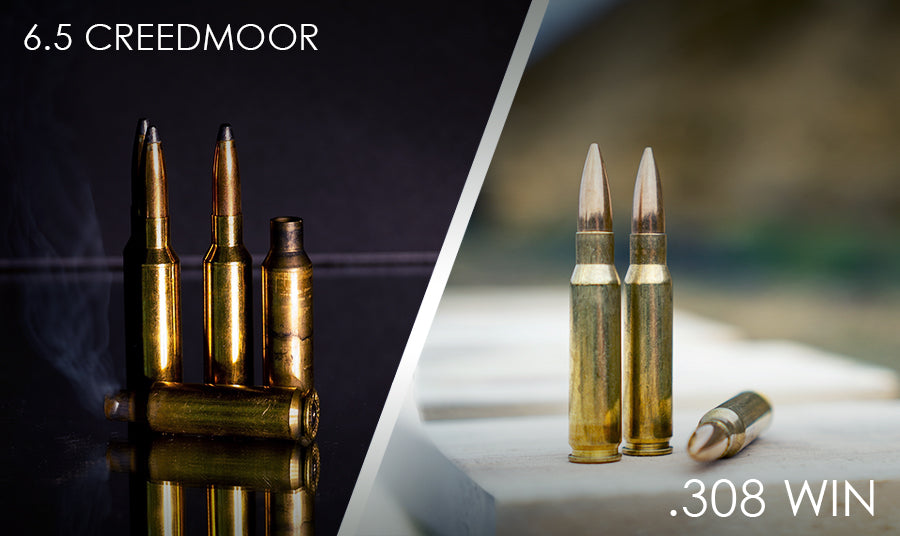|
|
.308 |
6.5 Creedmoor |
|
Year Designed |
1952 |
2007 |
|
Example Bullet Weight |
125gr |
125gr |
|
Example Powder |
748 |
748 |
|
Est. Maximum Velocity |
3,175 fps |
2,941 fps |
|
Pressure |
57,898 PSI |
60,400 PSI |
6.5 Creedmoor vs. .308 Winchester: A Hunter's Guide to Choosing the Perfect Cartridge
When it comes to selecting the ideal cartridge for hunting, the 6.5 Creedmoor and .308 Winchester are two renowned options that have earned their place among hunters and shooting enthusiasts. The debate has been raging ever since Hornady created the 6.5 Creedmoor as a direct competitor to the .308 Winchester, and will most likely be as storied as the ongoing argument between the 7.62x39 and the 5.56x45.
The .308 Winchester: A Battle-Proven Classic
The .308 Winchester was originally developed in 1952 as a big game hunting round to replace the .300 Savage. The hard-hitting round eventually caught the attention of NATO, which used it as the basis of their 7.62x51mm NATO round. The .308 holds a special place in the hearts of many hunters and shooters as the last of the Western full-size military cartridges, since after the 7.62x51mm's heyday, militaries around the world transitioned to intermediate-sized cartridges like the 5.56x45mm. With its roots tracing back to the M14 rifle, which continues to serve in the form of the Mk14 EBR, the .308 Winchester has proven itself in the harshest of conditions. It offers a reliable and time-tested performance that many hunters appreciate.
Advantages:
Larger diameter bullet.
The .308 Winchester has a larger bullet diameter than its 6.5 Creedmoor counterpart, which has a diameter of .264 inches. This results in greater tissue damage and blood loss in whatever the .308 hits.
Mushrooming.
Thanks to its size, the .308 Winchester produces greater cavitation than the 6.5 Creedmoor, causing more damage to internal organs.
Ammunition Variety.
The .308 has been a large caliber mainstay for decades, and as such has a greater variety of commercially available loads than the 6.5 Creedmoor.
Disadvantages:
Greater recoil and drift.
Compared to the 6.5 Creedmoor, the .308 has 25% more recoil than the 6.5 and tends to drift significantly at ranges greater than 800 to 1000 yards.
Limited range and velocity retention beyond 400 yards.
While the .308 is capable of shooting at long ranges, the 6.5 Creedmoor is better. Its velocity also tends to experience a rapid slowdown after 400 yards.
The 6.5 Creedmoor: Precision and Versatility
Created by Hornady, the 6.5 Creedmoor was developed with the intention of surpassing the performance of the .308 Winchester in specific areas. It was engineered to deliver outstanding accuracy, reduced recoil, minimal drift, and a flatter trajectory, making it an excellent choice for long-range shooting. The Creedmoor name came from the historic Creedmoor rifle range in New York.
Advantages:
Superior accuracy and precision.
Since its inception, the 6.5 Creedmoor was envisioned as a precision long range cartridge specifically engineered to outperform the .308 Winchester. It has twice the hit probability of a .308 at 1,000 yards.
Reduced recoil.
With 25% less recoil than a .308, the 6.5 Creedmoor allows faster follow-up shots and increased shooter comfort.
Minimal drift.
The 6.5 Creedmoor flies so flat that it has 1.5 feet less drift at 1,000 yards compared to the .308 Winchester.
Longer effective range.
While most rifles chambered in .308 have maximum effective ranges of 800 to 1000 yards, rifles in 6.5 Creedmoor typically have maximum ranges pushing 1,500 yards.
Disadvantages:
Smaller diameter bullets.
While the 6.5 Creedmoor is accurate, it had to reduce its diameter to achieve its potent ballistics, resulting in a slightly smaller round with less tissue damage.
Limited load variety.
Compared to the .308 Winchester, which has been on the market for over half a century, the 6.5 Creedmoor is a newcomer to the market with less load options, but they are still easier to find than specialty or historical surplus cartridges like the 8x50mmR.
Barrel erosion.
The 6.5 Creedmoor’s barrel tends to warp faster than the .308’s. Some shooters experience noticeable changes in accuracy after 2,000 rounds, but others will continue shooting with relatively good accuracy until 3,000.
As a hunter, the choice between the 6.5 Creedmoor and .308 Winchester depends on your specific requirements and preferences. If you prioritize long-range accuracy, reduced recoil, and minimal drift, the 6.5 Creedmoor is the clear winner. Its exceptional precision and extended range make it an ideal choice for hunters seeking to engage targets at greater distances.
On the other hand, if you value the proven reliability and versatility of a battle-tested cartridge, the .308 Winchester remains a formidable option. Its larger diameter bullets deliver increased tissue damage and blood loss, while its durability and wide range of available loads ensure adaptability in various hunting scenarios.
Ultimately, both cartridges have their unique advantages and disadvantages. By carefully considering your hunting needs, preferences, and shooting style, you can confidently select the cartridge that best suits your requirements. Happy hunting!
If our products have helped you in any way, share your story with us! Accepted stories will receive a 20% discount code.





